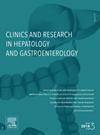Fecal calprotectin, intestinal ultrasound, and their combination for the diagnosis of inflammatory bowel disease
IF 2.6
4区 医学
Q2 GASTROENTEROLOGY & HEPATOLOGY
Clinics and research in hepatology and gastroenterology
Pub Date : 2025-02-03
DOI:10.1016/j.clinre.2025.102549
引用次数: 0
Abstract
Background
We aimed to evaluate the diagnostic accuracy of fecal calprotectin (FC) and intestinal ultrasound (IUS), independently and in combination, as screening tools for adults with suspected IBD to reduce the number of unnecessary endoscopic procedures.
Methods
We conducted a retrospective monocentric study that included consecutive adult patients with (i) ileocolonoscopy for suspected IBD between January 2021 and June 2023 who had either (ii) IUS and/or (iii) a FC test within 6 weeks. Bowel wall thickness (BWT) and the color Doppler signal (CDS) were evaluated for all segments. The presence of lymphadenopathy, loss of stratification, stricture, and fistula were also recorded.
Results
In total, 119 patients with a median age of 32 years (IQR, 24.0–41.0) were included. The most common symptoms were abdominal pain (n = 88, 75 %) and chronic diarrhea (n = 89, 75 %). Among the 119 patients, 74 (62 %) had IUS, 101 (82 %) had a FC test, and 56 (47 %) had both. Forty patients (34 %) had a diagnosis of IBD, including 31 (26 %) with CD and 9 (8 %) with UC. By ROC curve analysis, the best threshold of FC to diagnose IBD was 117 ug/g (Se 97 %, Sp 73 %, PPV 67 %, NPV 98 %, AUC 0.88, 95 %CI [0.81; 0.94], p = 0.006). Using this threshold, only 3 % of patients were misclassified as non-IBD. Screening by measuring FC levels would result in a 48 % reduction in the number of adults requiring endoscopy. Abnomal IUS was significantly associated with a diagnosis of IBD (OR 5.6, 95 %IC [2.1;16.2], P = 0.0008). The association of a BWT>3 mm and a positive CDS was associated with a Se, Sp, PPV, and NPV of 48 %, 100 %, 100 %, and 75 %, respectively, but 52 % of patients were misclassified as non-IBD. The combination of a BWT>3 mm, CDS, and FC>117 ug/g had a Se, Sp, PPV, and NPV of 44 %, 100 %, 100 %, and 69 %, respectively. For patients with a normal IUS and FC<117 ug/g, 4 % were misclassified as non-IBD.
Conclusions
The combination of FC and IUS is a useful screening strategy to identify patients who truly require endoscopy for suspected IBD. Calprotectin is a highly effective test for ruling out IBD. Conversely, relying solely on IUS lacks the discriminative power to safely rule out IBD. However, it shows a high PPV and is a potent tool for diagnosing IBD.
求助全文
约1分钟内获得全文
求助全文
来源期刊

Clinics and research in hepatology and gastroenterology
GASTROENTEROLOGY & HEPATOLOGY-
CiteScore
4.30
自引率
3.70%
发文量
198
审稿时长
42 days
期刊介绍:
Clinics and Research in Hepatology and Gastroenterology publishes high-quality original research papers in the field of hepatology and gastroenterology. The editors put the accent on rapid communication of new research and clinical developments and so called "hot topic" issues. Following a clear Editorial line, besides original articles and case reports, each issue features editorials, commentaries and reviews. The journal encourages research and discussion between all those involved in the specialty on an international level. All articles are peer reviewed by international experts, the articles in press are online and indexed in the international databases (Current Contents, Pubmed, Scopus, Science Direct).
Clinics and Research in Hepatology and Gastroenterology is a subscription journal (with optional open access), which allows you to publish your research without any cost to you (unless you proactively chose the open access option). Your article will be available to all researchers around the globe whose institution has a subscription to the journal.
 求助内容:
求助内容: 应助结果提醒方式:
应助结果提醒方式:


